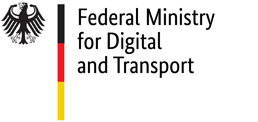Seeärztlicher Dienst
Brandstwiete 1
20457 Hamburg
Phone: +49 40 361 37-365
Fax: +49 40 361 37-333
Mail: seeaerztlicher-dienst@bg-verkehr.de

Dr. Jörg Abel
Phone: +49 40 36137-336
Fax: +49 40 36137-333
Mail: joerg.abel@bg-verkehr.de

Beate Bahl
Phone: + 49 40 36137-338
Fax: +49 40 36137-333
Mail: beate.bahl@bg-verkehr.de

Ana Strickert
Phone: +49 40 36137-365
Mail: ana.strickert@bg-verkehr

Jan Schultz
Phone: +49 40 36137-335
Fax: +49 40 36137-333
Mail: jan.schultz@bg-verkehr.de

Annelie Ewen
Phone: +49 40 36137-252
Fax: +49 40 36137-333
Mail: annelie.ewen@bg-verkehr.de
Kolinda Cinfe
Phone: +49 40 36137-350
Fax: +49 40 36137-333
Mail: kolinda.cinfe@bg-verkehr.de
Marina Staude
Phone: +49 40 36137-340
Fax: +49 40 36137-333
Mail: marina.staude@bg-verkehr.de
Wasserstraßen- und Schifffahrtsamt (WSA) Ostsee
WSA Ostsee - Kontakt
Medical equipment • spaces
- Optimal medical equipment
- Current standard of medical equipment
- Emergency cards
- Emergency bag
- Medical spaces are attuned with the equipment
- On-board medical treatment in treatment room
- Additional sickbay to separate sick people
The optimal medical equipment on board of German seagoing ships
According to the Maritime Labour Convention, seafarers have a right to get – as far as this is possible - a comparable medical standard as employees do at land.
With few exceptions, such as cruise liners, seagoing ships do not have a doctor on board. Medical care is in the hands of the master or, on larger ships, of a deck officer. Therefore, the medical equipment on board must be suitable for medical care of ill or injured persons by non-professionals who have undergone a specific basic medical training.
Current standard of medical equipment on board of German seagoing ships
The medical equipment on board seagoing ships under German flag meets a seafarer's needs in an optimal way. The equipment varies depending on the shipping area and number of people on board. It is also kept up to the standard of the latest medical progress.
Current State of Medical Knowledge
We have compiled an overview (in German only) of the changes of the current state of medical knowledge in comparison to the previous version.
The trading areas are in our maps
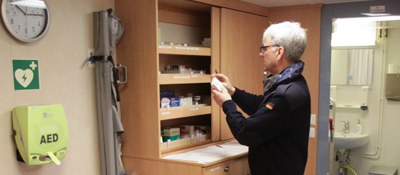
The standard of medical equipment is established by the Committee for medical equipment in the maritime shipping sector ("Ausschuss für medizinische Ausstattung in der Seeschifffahrt"). The committee consists of competent experts for maritime medicine in Germany as well as of deck officers and of a lawyer. More information is given in the flyer by the Federal Ministry of Transport.
Medical equipment on board comprises:
- medicine, medical devices and other aids,
- Maritime Medical Handbook,
- emergency bag and cards,
- controlled drugs register,
- patients’ register,
- medical report forms.
Find out more about the Maritime Medical Handbook
Emergency cards: life-saving information at the emergency site
In a medical emergency, the first few minutes are decisive – immediate aid can save lives. In case of an accident on board a seagoing vessel, the way from the emergency site – for example in the engine room – to the on-board hospital can be far and may take a long time to get there. In such cases, the emergency cards by the Maritime Medical Service aid with the most important first medical measures on the site.
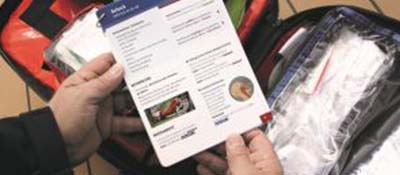
Theses 22 emergency cards are an integral part of the emergency bag that the medical response take with them as they rush to the scene of the accident. The emergency cards are concise and harmonized with the "Maritime Medical Handbook" and the medication and medical aids contained in the emergency bag.
The emergency cards have been specifically developed with the medical care performed by navigational officers and masters on board ships in mind. A student at the "Hochschule für Angewandte Wissenschaften" (HAW – University of Applied Sciences) conducted an online survey among 125 navigational officers and masters on behalf of the Maritime Medical Service. Its goal was to find out what their future users where looking for in such cards. The notes of these future users have been taken into account in the development of the emergency cards and make them especially practice-oriented.
The emergency cards are bilingual – the front is in German and the back in English. They are available at Akamedica-Shop.
The emergency bag: all essential medication and aids on site
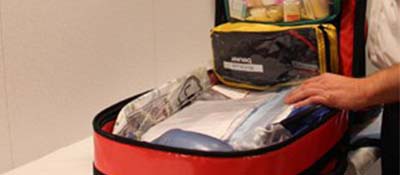
The contents of the emergency bag as well as the emergency cards facilitate necessary first medical measures on board. This way injured or acutely sick persons can be stabilized for transport to the on-board hospital where the navigational officers and masters can proceed with further treatment, aided by the Maritime Medical Handbook.
The emergency bag consists of four colour-coded modules that help to get a quick overview. The blue module, for example, contains medication for respiratory diseases, the red module medication for cardiovascular diseases. The emergency cards refer to this colour code. This way, the ship's officer treating the patient can quickly find the required medication in the emergency bag.
The emergency bag – and therefore the emergency cards – are mandatory under German Flag on:
- All merchant ships on international voyages
- merchant ships with 100 or more persons on board on national and near-coastal voyages and
- high sea and deep sea fishing vessels.
Medical spaces are attuned with the equipment
Large ships going on long voyages have to be equipped with a treatment room with a medical chest. The arrangement of the room is attuned with the medical equipment determined by the committee and with the medical training courses and the refresher courses for ships’ officers.
Recommendations for arrangement of medical spaces
The committee for medical equipment published its recommendations for the equipment of medical spaces on merchant vessels flying the German flag. You can follow this guidance for a change of flag or a newbuilding. These recommendations are not legally binding. Subsection 7 of the Ordinance on Accommodation in Maritime Shipping (MaritimeAccommodationO, See-Unterkunftsverordnung) is legally binding.
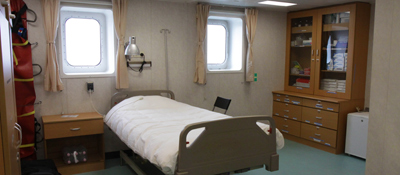
People receive on-board medical treatment in the treatment room
For the best possible on-board care of patients §§ 22-24 of the Ordinance on Accommodation in Maritime Shipping (MaritimeAccommodationO, See-Unterkunftsverordnung) instructs a separate treatment room and often a sickbay. A treatment room is instructed for:
- All ships on worldwide routes,
- vessels with 15 or more people on board with duration of the voyage of more than three days,
- passenger ship on worldwide routes and European routes (more detailed information can be found in § 46 of the German Maritime Labour Act (Seearbeitsgesetz), and
- ships engaged in deep sea fishing.
In the treatment room patients are treated medically. Communication equipment facilitates a direct telemedical maritime assistance by radio or satellite. The treatment room is easily accessible and state-of-the-art. The medical chest (on-board pharmacy) is to be installed inside the hospital accommodation; The Pharmaceuticals have to be sorted according to a specified loading plan (see annex to Ordinance on Accommodation in Maritime Shipping).
Additional sickbay to separate sick people
Ships with a treatment room - except passenger ships on European routes with less than 12 hours duration of the voyage - are required to have a sickbay available. It serves to separate patients with contagious diseases to stop the pathogenic agents from spreading.
The one to two bed sickbay is arranged with a hand washbasin, either a bathtub or a shower as well as a separate toilette room. Both rooms are equipped with a telephone or a call system. On a ship with up to 30 people, a sickbay can be dispensed with if all single-bedrooms have a detached sanitary module.

